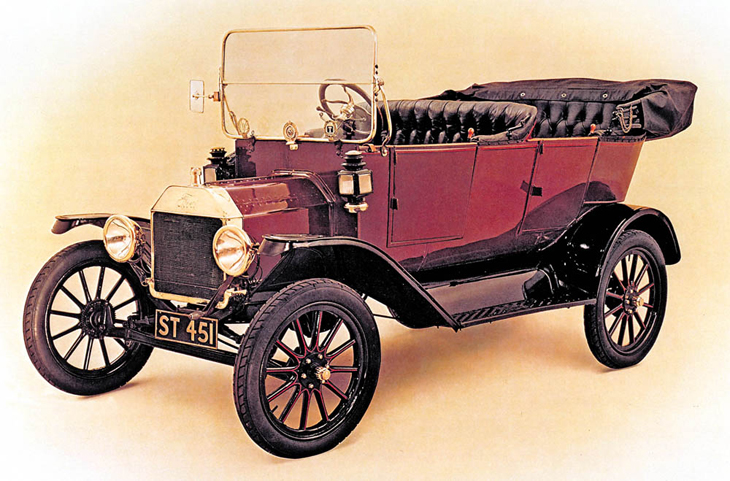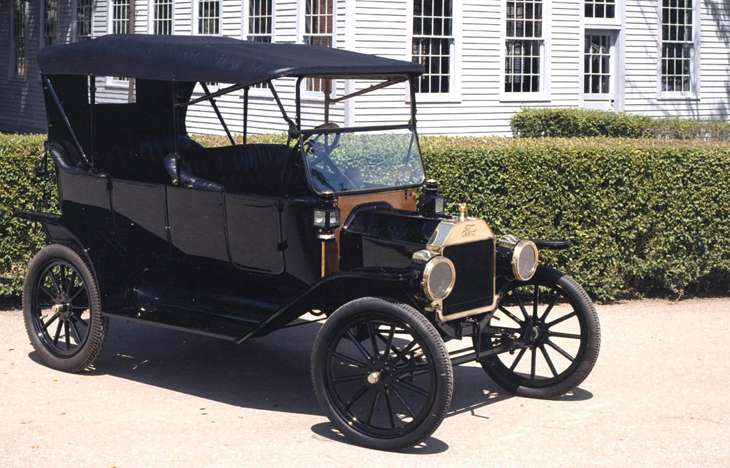|
|
|
|
1927 The People's Car Ford Model T (1908-1927)
There are no original Model T parts on these cars, but each is interchangeable with the original, including the hand crank located under the radiator. Top end speed of the T 100 is about 55 mph, and they get about 18 miles to the gallon in their nine-gallon tank, about the same as an original 1914 Model T.
TOP 10 WAYS FORD'S MODEL T CHANGED THE WORLD In 2008, Ford Motor Company celebrated the 100th anniversary of the car credited with "putting the world on wheels," the Model T. Henry Ford's iconic vehicle, which officially brought the world into the age of the "horseless carriage," also is responsible for hundreds of innovations that jumpstarted the automotive industry as we know it. This list focuses on the 10 most important influences of the Model T and how the world was forever changed by them. 1. King of the assembly line - The Model T brought mobility and prosperity on an undreamed of scale through manufacturing efficiencies at a price that anyone could afford. The mass production process perfected the moving assembly line, creating and defining the industrial age and enabling Ford to steadily decrease the price of the Model T. In 1908, the first Model Ts sold for $825. By 1925, it sold for only $260. 2. Friend of the factory worker - The Model T is responsible for establishing a minimum wage and the eight-hour work day. The $5 a day minimum wage brought the best workers to the Ford factories and is often cited as having helped establish the middle-class. The factory work also gave jobs to people who usually could not find work such as immigrants, women, minorities and people with disabilities. 3. Personalize it - Over the years, thousands of Model T accessories have been sold. Because of this, the car spurred the aftermarket supplier industry, which is now a $38 billion industry annually. Anytime you see a car with anything from a bumper sticker to chrome wheels, know that the Model T started the customization trend. 4. The Universal Car - Model T stands out as the industry's truly the first global car. By 1921, it accounted for almost 57 percent of the world's automobile production. It also was manufactured in several countries and had dealerships in six continents. 5. The American Way - Before the Model T, early cars might have a steering wheel on the right, left, or in the center of the front seat. The Model T standardized the left-hand steering wheel. 6. Any Color As Long As It's Black - The myth that the Model T only came in black probably comes from the reality that almost 12 million of the 15 million total Model Ts were black. But, in the early and late years of Model T production, the car was produced in many different colors, including blue, red, green and grey. Oddly, many these hues were so dark they were hardly discernable from black, another reason the myth lives on. 7. Built Ford Tough - By 1925, Ford was building its first factory-produced domestic pickup truck - the Ford Model T Runabout - with a pickup body. Ford also offered a heavier-duty, one-ton-rated Model TT pickup - akin to today's F-Series Super Duty. The Model T chassis was simple, strong and lightweight, with a unique three-point suspension that isolated the frame and powertrain from road shock that would cause other less sophisticated chassis designs to flex under heavy loads. 8. Look at that thing go! - Tin Lizzie's original engines offered flexibility and boasted 20 hp, with a top speed of 40-45 mph. The front-mounted, 2.9-liter, four-cylinder, flex-fuel engine was the first single block motor with removable cylinder head and today remains the basis for most modern engines. The engine could be matched to one of nine T body styles, all built on the same chassis. The Touring, Roadster, Fordor, Coupe, and Sedan were just some of the options. The Model T set the groundwork for modern cars that share the same chassis but are completely different from each other. 9. Tin Lizzie, a Pop Culture Icon - Soon after the Model T appeared in dealer showrooms, it started appearing in movies, songs, and became part of modern language and culture. The Model T was featured in 1920s black-and-white comedies and became the subject of hundreds of jokes and cartoons that captured the experience about life with the Model T, the personality of the car and its creator, Henry Ford. Hundreds of songs and even whole music albums were created as the Model T became part of pop culture, later generating dozens of nicknames for the car. The most common - "Tin Lizzie" - was the moniker that had several possible origins ranging from the popularity of the female name "Lizzie" during that period to a famous Model T racecar named "Old Liz." 10. The Car of the Century - The Model T was the best-selling vehicle ever, until 1972 when the VW bug finally surpassed it. During 19 years of production, more than 15 Million Model Ts had been sold by May 26, 1927, when a ceremony marked the formal end of Model T production. More than 20 years later in 1999, a panel of 126 automotive experts from 32 countries still chose the Model T as the most influential car of the 20th century. page 2 | page 3 | page 4 | page 5 | page 6 | page 7
|
|
Home < Ford Group < Ford Cars < History
|

